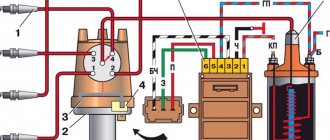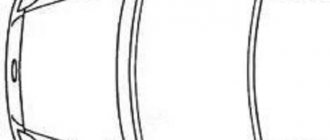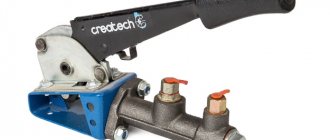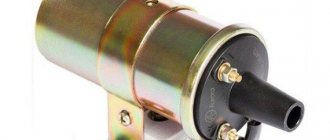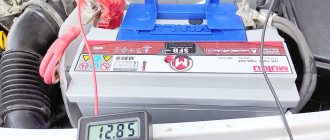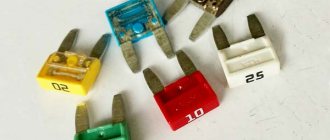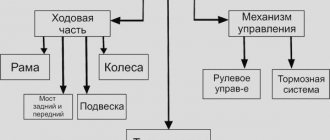Advantages and disadvantages of car cigarette lighters
Once a cigarette lighter appears in a car, it remains an integral part of the equipment.
With the development of technology, many devices have appeared that require sufficient power from the vehicle’s on-board network. AP began to be used as a car socket. The operating principle of the device has not changed over the years. But various tees and adapters appeared that expanded the possibilities of using AP (the author of the video is Do It Yourself).
The main advantage of a car cigarette lighter is the ability to connect a large number of different electrical appliances that may be needed on a long trip or will increase the comfort of the trip.
Since large amounts of current pass through the AP, its design is unreliable. In addition, the device constantly experiences additional mechanical stress due to the constant connection of various devices. During the trip, due to vibration, the contact between the AP and the socket is broken. As a result, sparks may appear, which may even cause a short circuit.
Don't burn out at work: how to connect several gadgets to the cigarette lighter?
In the summer, their owners usually only connect smartphone chargers and DVRs, which consume a nominal current, to the on-board network of their cars. But in the fall and winter, “pop warmer” capes, remote fan heaters, electric mugs, thermal glass scrapers and other car heating gadgets are plugged into cigarette lighters. All this junk, as a rule, is powered simultaneously through cigarette lighter splitters that have from two to five sockets, as a result of which many car owners encounter problems. And it would be okay if a contact came loose somewhere or a plug melted, but you can also burn your car... How can you not do this?
Who is guilty?
Physics and electrical engineering clearly state: in order to transmit large currents through detachable connections, the connectors must have a significant contact area, low self-resistance and be sufficiently tight. To understand the essence of the processes occurring in the car cigarette lighter socket and the corresponding plug of a 12-volt gadget, let’s disassemble the plug and take a look at its guts.
Electrical circuit of the device
To successfully repair an AP, you must have at least basic knowledge of electrical engineering and know how the electrical circuit of the device works: where is the plus and where is the minus.
You can use a multimeter to find plus and minus.
Photo gallery “Cigarette lighter and its circuits”
In a car cigarette lighter, the plus is a handle-button that the user presses. When you press the button, the electrical circuit closes and the coil begins to heat up. The downside is the sides of the metal casing of the AP.
Knowing the polarity of the device, it will not be difficult to repair the car cigarette lighter.
To do this you need to do the following:
- Unscrew the nut on the back side of the AP.
- Next, we disassemble the device.
- At the bottom of the device is a semiconductor wafer. This may be the cause of the malfunction. In this case, it must be removed.
- On the body you need to cut off the protrusion using a file.
- Now the device needs to be assembled.
- Next, you should strip the wires not 7 mm in order to then connect them. In addition, you need to press the terminals on them.
- In the cabin, it is necessary to dismantle the center console and turn off the backlight.
- We take out the block and connect the wires using special clips. We connect the white-brown wire to the wire from the backlight. All that remains is to connect the yellow and black wires to the AP wires.
- Then the wires are laid down and connected to the plug from the car cigarette lighter.
- Next, the cigarette lighter is returned to its place, and the backlight is connected.
Let's figure out where the plus and minus are in the cigarette lighter: is it possible to mix it up?
If previously a car cigarette lighter (CA) was used only for its intended purpose, recently many devices have appeared that can be connected to the on-board network through it. The article discusses the car cigarette lighter: where are the plus and minus, advantages and disadvantages.
Advantages and disadvantages of car cigarette lighters
Once a cigarette lighter appears in a car, it remains an integral part of the equipment.
With the development of technology, many devices have appeared that require sufficient power from the vehicle’s on-board network. AP began to be used as a car socket. The operating principle of the device has not changed over the years. But various tees and adapters appeared that expanded the possibilities of using AP (the author of the video is Do It Yourself).
The main advantage of a car cigarette lighter is the ability to connect a large number of different electrical appliances that may be needed on a long trip or will increase the comfort of the trip.
Since large amounts of current pass through the AP, its design is unreliable. In addition, the device constantly experiences additional mechanical stress due to the constant connection of various devices. During the trip, due to vibration, the contact between the AP and the socket is broken. As a result, sparks may appear, which may even cause a short circuit.
Electrical circuit of the device
To successfully repair an AP, you must have at least basic knowledge of electrical engineering and know how the electrical circuit of the device works: where is the plus and where is the minus.
You can use a multimeter to find plus and minus.
Photo gallery “Cigarette lighter and its circuits”
In a car cigarette lighter, the plus is a handle-button that the user presses. When you press the button, the electrical circuit closes and the coil begins to heat up. The downside is the sides of the metal casing of the AP.
Knowing the polarity of the device, it will not be difficult to repair the car cigarette lighter.
To do this you need to do the following:
- Unscrew the nut on the back side of the AP.
- Next, we disassemble the device.
- At the bottom of the device is a semiconductor wafer. This may be the cause of the malfunction. In this case, it must be removed.
- On the body you need to cut off the protrusion using a file.
- Now the device needs to be assembled.
- Next, you should strip the wires not 7 mm in order to then connect them. In addition, you need to press the terminals on them.
- In the cabin, it is necessary to dismantle the center console and turn off the backlight.
- We take out the block and connect the wires using special clips. We connect the white-brown wire to the wire from the backlight. All that remains is to connect the yellow and black wires to the AP wires.
- Then the wires are laid down and connected to the plug from the car cigarette lighter.
- Next, the cigarette lighter is returned to its place, and the backlight is connected.
Cigarette lighter - where is the plus and minus
This car device is used even by non-smoking car owners. After all, the device has excellent functionality that goes far beyond its name.
The following devices can be connected to the cigarette lighter socket:
- charger for a phone, tablet or other electronic device;
- compressor for inflating wheels;
- navigation complex;
- DVR;
- 12 volt socket.
However, over time, the cigarette lighter may fail or require repair. When connecting a new spare part, you must observe the polarity of the wires, know where the plus is and where the minus is. The article provides information and instructions on how to replace or repair the element.
Where is the plus and minus in the car cigarette lighter: pinout, polarity
This car device is used even by non-smoking car owners. After all, the device has excellent functionality that goes far beyond its name.
The following devices can be connected to the cigarette lighter socket:
- charger for a phone, tablet or other electronic device;
- compressor for inflating wheels;
- navigation complex;
- DVR;
- 12 volt socket.
However, over time, the cigarette lighter may fail or require repair. When connecting a new spare part, you must observe the polarity of the wires, know where the plus is and where the minus is. The article provides information and instructions on how to replace or repair the element.
Pinout and desoldering information
The cigarette lighter device can be seen in the photo. At the end of the part there is a contact terminal. Inside there are special holders, a heating element and a cup. There are connector tabs and a return spring. And for safety from burns there is a special insulator. All this is protected by a plastic case.
A detailed diagram of the pinout and wiring of the cigarette lighter wires is presented in the video.
Where is the cigarette lighter fuse located?
A burnt-out protective element may be the result of connecting one powerful device or several devices to the socket.
Because of this, the current strength in the wires exceeds a critical value, as a result of which the fuse melts. This may happen because the owner has confused where the plus and where the minus is in the cigarette lighter.
This malfunction is treated by removing the burnt out element and installing a new one.
Replacing the cigarette lighter fuse
To carry out the procedure, you should have instructions for a specific car. Each machine has its own mounting block location and fuse assignment. You need to know where the plus and minus are.
On most cars, the box is located directly behind the front panel. However, on classics, fuse No. 6 is responsible for the operation of the cigarette lighter, and on some other models - the turn relay. Therefore, when making repairs, you should know which element we plan to change and where it is located. It is necessary to buy a fuse with the resistance recommended by the manufacturer.
Installing a second cigarette lighter
Many drivers lack an additional socket. There are several ways out of this situation. The simplest one is to install a special splitter that plugs into a standard connector. However, this can put a lot of stress on the circuit and cause the wires and fuse to blow. Therefore, some car owners install an additional car cigarette lighter.
The second method is more difficult, but more reliable. The procedure is carried out as follows.
- We choose a suitable location for the additional device.
- We are purchasing a new spare part. The black wire is the ground that we mount under the bolt on the body. Red is a plus, it goes to the battery, and yellow is responsible for the backlight of the device.
- Cut a hole of suitable diameter.
- We install a new spare part.
- We connect all the wires, remembering where the plus and minus are in the cigarette lighter.
- We remove debris and perform final assembly. Now the owner has two nests at his disposal.
Pros or cons of multiple cigarette lighters
Old cars, for example, the classic VAZ, have a different device design. There is a long cigarette lighter with its pros and cons. This device has been developed for a long time, so it has a number of technological shortcomings. The disadvantages include:
- Inability to connect multiple devices to the cigarette lighter.
- Weak contacts. Over time, due to age or frequent driving on rough roads, the antennae of the cigarette lighter itself may become loose. This disrupts the operation of the device and can lead to its failure.
- The disadvantages include the appearance of the old cigarette lighter, which is much worse. The light bulb does not shine as brightly or often burns out.
Car cigarette lighter polarity
Sometimes an element fails. Frequent malfunctions are as follows.
- Blown fuse. A special protective element is installed on the electrical circuit, designed for a current of 10 Amps. When a malfunction or short circuit occurs, it burns out to keep the cigarette lighter, wires and instruments working. This element is responsible for several more devices. If the cigarette lighter and the clock do not work, then you should get to the mounting block and replace the fuse.
- Oxidized contacts. Over time or from connecting powerful devices to the cigarette lighter (such as a compressor or car charger), the metal connectors can oxidize. Before replacing, it is advisable to remove the cartridge and inspect the antennae for the appearance of oxides. If there are such moments, they should be cleaned and bent for a better connection. Before carrying out the procedure, it is recommended to remove the negative terminal from the car battery. This will prevent a short circuit. You need to know where the plus and minus are.
- Waste car cigarette lighter incandescent element. The nichrome spiral located inside the cartridge can also burn out. This will entail installing a new cigarette lighter.
- Short circuit or broken wiring. Cables may fray or melt as a result of shortening. You can determine such a malfunction of the car cigarette lighter using a multitester. It is necessary to check the integrity of the wires.
Car cigarette lighter device
p, blockquote 5,0,0,0,0 —>
Despite its apparent simplicity, the car cigarette lighter device is a rather complex technical design:
p, blockquote 6,0,0,0,0 —>
p, blockquote 7,0,0,0,0 —>
The central contact 1 is supplied with a supply voltage of + 12 Volts through a fuse rated 10 - 30 Amps (depending on the type of cigarette lighter and the make of the car). The working element 9 is usually made of a spiral heating nichrome plate. Its central contact is connected to pin 1 (supply voltage) after pressing button 6 of the removable element of the cigarette lighter 5.
p, blockquote 8,0,0,0,0 —>
Bimetallic plates 10 record the moment of pressing the removable element to the cigarette lighter contact. As the electrical element 9 heats up, the temperature of the bimetallic plates increases, they change their geometric dimensions, the fastening of the clamps is weakened, and the spring 3 pushes the removable part out of the socket, thereby signaling the moment of complete heating.
p, blockquote 9,0,0,0,0 —>
Most modern cigarette lighters have a light bulb or LED elements to illuminate the socket at night.
p, blockquote 10,0,0,0,0 —>
Correct connection of the cigarette lighter
You can repair a car device, dismantle it or install it yourself. To replace the cigarette lighter you will need the following list of tools:
- Phillips/minus screwdriver;
- blowtorch with solder;
- connecting terminals for plus and minus.
Repair is carried out as follows.
- We dismantle the car cigarette lighter. It is removed differently in each car. Sometimes you just need to pry the cartridge, and sometimes you have to remove the lining of the central tunnel.
- We disassemble the car cigarette lighter. We find the semiconductor wafer at the bottom. This is what often causes breakdowns. Let's delete it.
- We cut off the protrusion on the outer casing.
- We assemble the cigarette lighter in the reverse order of disassembly.
- We strip the connection wires at least 5 mm.
- We connect the car cigarette lighter wires, observing the polarity, where is positive and where is minus. You can use a blowtorch or a special terminal block and clamps.
- We dismantle the center console for reverse connection.
- Disconnect the backlight unit.
- We stretch the wires and then connect them to the car cigarette lighter connector.
- We carry out the assembly process in reverse order.
Pinout and desoldering information
The cigarette lighter device can be seen in the photo. At the end of the part there is a contact terminal. Inside there are special holders, a heating element and a cup. There are connector tabs and a return spring. And for safety from burns there is a special insulator. All this is protected by a plastic case.
A detailed diagram of the pinout and wiring of the cigarette lighter wires is presented in the video.
Cigarette lighter plug connection diagram
Before installing a new part, you need to understand the polarity. You can understand where the plus and where the minus is on the cigarette lighter by looking at the photo.
There are three different wires going to the device.
- Red goes into the battery and is responsible for additional devices such as a watch.
- The yellow one, central, also goes to the battery. This is the socket light bulb.
- Black side – minus, mass. Located on the body of the part.
When the device needs to be replaced, it should be connected according to the diagram shown in the photo.
Where is the cigarette lighter fuse located?
A burnt-out protective element may be the result of connecting one powerful device or several devices to the socket. Because of this, the current strength in the wires exceeds a critical value, as a result of which the fuse melts. This may happen because the owner has confused where the plus and where the minus is in the cigarette lighter. This malfunction is treated by removing the burnt out element and installing a new one.
Replacing the cigarette lighter fuse
To carry out the procedure, you should have instructions for a specific car. Each machine has its own mounting block location and fuse assignment. You need to know where the plus and minus are.
On most cars, the box is located directly behind the front panel. However, on classics, fuse No. 6 is responsible for the operation of the cigarette lighter, and on some other models - the turn relay. Therefore, when making repairs, you should know which element we plan to change and where it is located. It is necessary to buy a fuse with the resistance recommended by the manufacturer.
Installing a second cigarette lighter
Many drivers lack an additional socket. There are several ways out of this situation. The simplest one is to install a special splitter that plugs into a standard connector. However, this can put a lot of stress on the circuit and cause the wires and fuse to blow. Therefore, some car owners install an additional car cigarette lighter.
The second method is more difficult, but more reliable. The procedure is carried out as follows.
- We choose a suitable location for the additional device.
- We are purchasing a new spare part. The black wire is the ground that we mount under the bolt on the body. Red is a plus, it goes to the battery, and yellow is responsible for the backlight of the device.
- Cut a hole of suitable diameter.
- We install a new spare part.
- We connect all the wires, remembering where the plus and minus are in the cigarette lighter.
- We remove debris and perform final assembly. Now the owner has two nests at his disposal.
Source
Where is the plus and where is the minus in a car cigarette lighter: pinout and polarity
Leading automakers began introducing cigarette lighters in their cars back in the 20s. last century. Since then, they have gained great popularity and have become an indispensable accessory on the dashboard of vehicles. The operating principle of the devices has not changed, but the capabilities and functions have been expanded.
How to properly use a car's cigarette lighter
A car cigarette lighter is a mandatory vehicle accessory. Recently, the malfunction of the cigarette lighter connector is especially noticeable, since it is often loaded with additional functions of powering and charging all kinds of gadgets.
p, blockquote 1,0,0,0,0 —>
p, blockquote 2,0,0,0,0 —>
They are also a possible cause of blown power fuses for the cigarette lighter socket and malfunction of the connector.
p, blockquote 3,0,0,0,0 —>
p, blockquote 4,0,0,0,0 —>
Design and principle of operation
The car cigarette lighter has a simple design and is a small metal cartridge with a plastic handle and button. A nichrome spiral is installed under the body, which is heated by electric current.
There is a special socket on the instrument panel or in another part of the car. If you insert the cigarette lighter into it and press the handle, it will be connected to the on-board network.
The positive contact mates with the central terminal of the socket and the spiral of the device. The negative interacts with the socket base and the plug clamping mechanism. When using the cigarette lighter, current is supplied through the nichrome element, which contributes to its heating.
After reaching the maximum temperature indicators, the thermal relay is activated, and the cigarette lighter is disconnected from the on-board power supply.
To protect the connector from blowing, manufacturers install a 10 A fuse. It is located in the fuse block and is indicated by the “cigar” marking or a cigarette icon.
Since its appearance in the first half of the 20th century. The internal structure of the cigarette lighter has remained virtually unchanged.
The key advantage of the device is the ability to power a variety of electrical appliances, which make long driving comfortable and safe.
However, due to the consumption of a large amount of energy, the structure may fail. In addition, there are other disadvantages of such an accessory. When gadgets are frequently connected, the internal elements of the device are subject to a large mechanical load, which contributes to their wear.
Most fork models have only spring elements and a few pressure forks. Therefore, when driving over rough terrain, natural vibrations are created that disrupt contact and lead to sparks in the cigarette lighter. This phenomenon can cause a short circuit and even lead to a fire.
Where is the plus in the cigarette lighter, where is the minus: pinout, car, polarity, plug, contacts, socket
Leading automakers began introducing cigarette lighters in their cars back in the 20s. last century. Since then, they have gained great popularity and have become an indispensable accessory on the dashboard of vehicles. The operating principle of the devices has not changed, but the capabilities and functions have been expanded.
Design and principle of operation
The car cigarette lighter has a simple design and is a small metal cartridge with a plastic handle and button. A nichrome spiral is installed under the body, which is heated by electric current.
There is a special socket on the instrument panel or in another part of the car. If you insert the cigarette lighter into it and press the handle, it will be connected to the on-board network.
The positive contact mates with the central terminal of the socket and the spiral of the device. The negative interacts with the socket base and the plug clamping mechanism. When using the cigarette lighter, current is supplied through the nichrome element, which contributes to its heating.
After reaching the maximum temperature indicators, the thermal relay is activated, and the cigarette lighter is disconnected from the on-board power supply.
To protect the connector from blowing, manufacturers install a 10 A fuse. It is located in the fuse block and is indicated by the “cigar” marking or a cigarette icon.
Since its appearance in the first half of the 20th century. The internal structure of the cigarette lighter has remained virtually unchanged.
The key advantage of the device is the ability to power a variety of electrical appliances, which make long driving comfortable and safe.
However, due to the consumption of a large amount of energy, the structure may fail. In addition, there are other disadvantages of such an accessory. When gadgets are frequently connected, the internal elements of the device are subject to a large mechanical load, which contributes to their wear.
Most fork models have only spring elements and a few pressure forks. Therefore, when driving over rough terrain, natural vibrations are created that disrupt contact and lead to sparks in the cigarette lighter. This phenomenon can cause a short circuit and even lead to a fire.
Where is the plus and where is the minus in the cigarette lighter?
To understand how the cigarette lighter works, where the plus and where the minus are, it is enough to examine its key components.
The plus point about the cigarette lighter is its handle. When you press the button, the electrical circuit is closed, and the nichrome spiral is heated. When wondering where the minus is on the cigarette lighter, you should pay attention to the side walls of the metal cylinder.
Using the polarity information as a guide, you can begin to repair the damaged part. To restore a failed element you need to:
- Unscrew the nut on the back side and remove the device.
- Find the semiconductor wafer and remove it (if it caused the breakdown).
- Make a small cut on the body and begin assembling the device.
- Strip the wires and crimp the terminals.
- Remove the center console in the car and turn off the backlight.
- Remove the block.
- Connect the wires using connecting clips, observing the diagram and polarity.
- Pull the wires down and connect them to the socket.
- Put the accessory in place.
- Turn on the backlight.
Where is the plus and where is the minus in the cigarette lighter?
To understand how the cigarette lighter works, where the plus and where the minus are, it is enough to examine its key components.
The plus point about the cigarette lighter is its handle. When you press the button, the electrical circuit is closed, and the nichrome spiral is heated. When wondering where the minus is on the cigarette lighter, you should pay attention to the side walls of the metal cylinder.
Using the polarity information as a guide, you can begin to repair the damaged part. To restore a failed element you need to:
- Unscrew the nut on the back side and remove the device.
- Find the semiconductor wafer and remove it (if it caused the breakdown).
- Make a small cut on the body and begin assembling the device.
- Strip the wires and crimp the terminals.
- Remove the center console in the car and turn off the backlight.
- Remove the block.
- Connect the wires using connecting clips, observing the diagram and polarity.
- Pull the wires down and connect them to the socket.
- Put the accessory in place.
- Turn on the backlight.
Plug
The plug is designed to transmit 12V/24V voltage through the cigarette lighter socket. Its body is made of plastic and has wires for screws. An 8A fuse is located inside the device, protecting the equipment from power surges.
Where are the pluses and minuses of a car cigarette lighter: polarity and operating features of the device
If previously a car cigarette lighter (CA) was used only for its intended purpose, recently many devices have appeared that can be connected to the on-board network through it. The article discusses the car cigarette lighter: where are the plus and minus, advantages and disadvantages.
Advantages and disadvantages of car cigarette lighters
Once a cigarette lighter appears in a car, it remains an integral part of the equipment.
With the development of technology, many devices have appeared that require sufficient power from the vehicle’s on-board network. AP began to be used as a car socket. The operating principle of the device has not changed over the years. But various tees and adapters appeared that expanded the possibilities of using AP (the author of the video is Do It Yourself).
The main advantage of a car cigarette lighter is the ability to connect a large number of different electrical appliances that may be needed on a long trip or will increase the comfort of the trip.
Since large amounts of current pass through the AP, its design is unreliable. In addition, the device constantly experiences additional mechanical stress due to the constant connection of various devices. During the trip, due to vibration, the contact between the AP and the socket is broken. As a result, sparks may appear, which may even cause a short circuit.
Electrical circuit of the device
To successfully repair an AP, you must have at least basic knowledge of electrical engineering and know how the electrical circuit of the device works: where is the plus and where is the minus.
You can use a multimeter to find plus and minus.
Photo gallery “Cigarette lighter and its circuits”
In a car cigarette lighter, the plus is a handle-button that the user presses. When you press the button, the electrical circuit closes and the coil begins to heat up. The downside is the sides of the metal casing of the AP.
Knowing the polarity of the device, it will not be difficult to repair the car cigarette lighter.
To do this you need to do the following:
- Unscrew the nut on the back side of the AP.
- Next, we disassemble the device.
- At the bottom of the device is a semiconductor wafer. This may be the cause of the malfunction. In this case, it must be removed.
- On the body you need to cut off the protrusion using a file.
- Now the device needs to be assembled.
- Next, you should strip the wires not 7 mm in order to then connect them. In addition, you need to press the terminals on them.
- In the cabin, it is necessary to dismantle the center console and turn off the backlight.
- We take out the block and connect the wires using special clips. We connect the white-brown wire to the wire from the backlight. All that remains is to connect the yellow and black wires to the AP wires.
- Then the wires are laid down and connected to the plug from the car cigarette lighter.
- Next, the cigarette lighter is returned to its place, and the backlight is connected.
Conclusion
Thus, you can restore the functionality of the car cigarette lighter yourself. The polarity of the car's cigarette lighter plays a big role in the process of connecting it. Therefore, it is important to understand well where the plus and minus of the device are located. It is advisable to consult a specialist and carefully study the instructions and recommendations of the manufacturer.
Video “Replacing the cigarette lighter”
This video demonstrates how to replace the AP without dismantling the tunnel (the author of the video is To the Village!).
- What to do if an essential attribute of any car - the cigarette lighter - does not work?
- Choosing adapters for the cigarette lighter - to help the practical driver
- How to choose the right adapter or adapter for a USB cigarette lighter?
Comments and reviews
Ivan Ivanovich Baranov
Experience working at a service station:
View all answers
Avtozam.com - your assistant in car repair and maintenance
Your use of this website constitutes your agreement that your use is at your own risk.
Useful for car enthusiasts - everything about cars
Needless to say, how necessary a cigarette lighter is in a car - and this basically has nothing to do with smoking. The thing is that the cigarette lighter socket serves as a power source for many electrical appliances when it is not possible to connect them to the main outlet.
What devices can be connected via the cigarette lighter:
- charger for mobile phone and tablet,
- DVR,
- navigator,
- radar detector,
- vacuum cleaner,
- car refrigerator,
- heated seats,
- perhaps a walkie-talkie,
- on old VAZs - car radio, etc.
The convenience of a cigarette lighter is undeniable, but there is also a drawback: you need to constantly keep under control the total power of all devices connected to the device - it should not be more than 120 watts, the current should not exceed 10 amperes.
The more intense the current, the more reliable the cigarette lighter contacts, which become loose from shaking and jolts while traveling, should be. As a result, a short circuit and fire occurs in the car. Various adapters and splitters, which allow you to connect several electrical appliances to the cigarette lighter at once, do not add reliability to the device, and thus significantly increase the load on it.
How to connect the cigarette lighter: sequence of work
The process of connecting the cigarette lighter begins with preparing the necessary tools: a file or needle file, soldering iron, screwdriver and pliers.
- To begin, remove the cigarette lighter and disassemble it;
- Remove the semiconductor wafer from it, it often interferes with the normal operation of the device;
- Use a file to file off the protrusion on the cigarette lighter body;
- Assemble the cigarette lighter;
- First you need to strip the wires with which it is connected and crimp the terminals onto them. Do not reverse the polarity of the connection!
- Remove the center console; Sometimes it may additionally be necessary to dismantle the lever casing and armrest in order to unscrew the screws;
- Remove the backlight wires, and then the entire unit;
- Now connect the wires, securing them with connecting clips. The wires are connected according to the following scheme: the brown wire is connected to the backlight wire, the black and yellow wires are connected to the cigarette lighter wiring. Remember to isolate each connection;
- Pull the wires down to connect to the cigarette lighter socket;
- Place the cigarette lighter in its seat in reverse order. First push through the ring, then the glass itself. If necessary, adjust the diameter of the ring to the diameter of the hole using a needle file;
- Replace the backlight.
Signs of an incorrect connection
If the cigarette lighter is connected incorrectly, it will malfunction or fail completely. In addition, deviation from the installation rules can cause a short circuit and lead to ignition of the element.
How to check
If the cigarette lighter refuses to conduct electricity, you should make sure that it is connected correctly.
To check the functionality of the device, you need to follow the following algorithm:
- Turn the ignition key and activate the electricity supply.
- Insert the cigarette lighter into the socket.
- Wait a few seconds and check the condition of the element with your hand. If it does not heat up, it means a breakdown has occurred.
Having completed the diagnostics, you should remove the device from the socket.
To restore the main function of the cigarette lighter, it is enough to change its head. If the nichrome spiral fails and is subject to wear due to intensive use, you can replace it with your own hands. The main thing is to choose the right model on the market.
If replacement does not fix the problem, you will need to check the power circuit and inspect all connections. At the inspection stage you should make sure:
- Are the contacts on the cigarette lighter body and connection points burnt out?
- Has the fuse, which is located in the corresponding compartment and is indicated by a cigarette icon or inscription, failed?
- Are there any traces of combustion or foreign particles in the nest?
- Is the socket plug OK?
Often, device malfunctions occur due to a damaged fuse. You can replace the part yourself without involving specialists.
If the device stops working, you can replace it yourself. The main thing is to figure out where the plus and minus are in the cigarette lighter.

